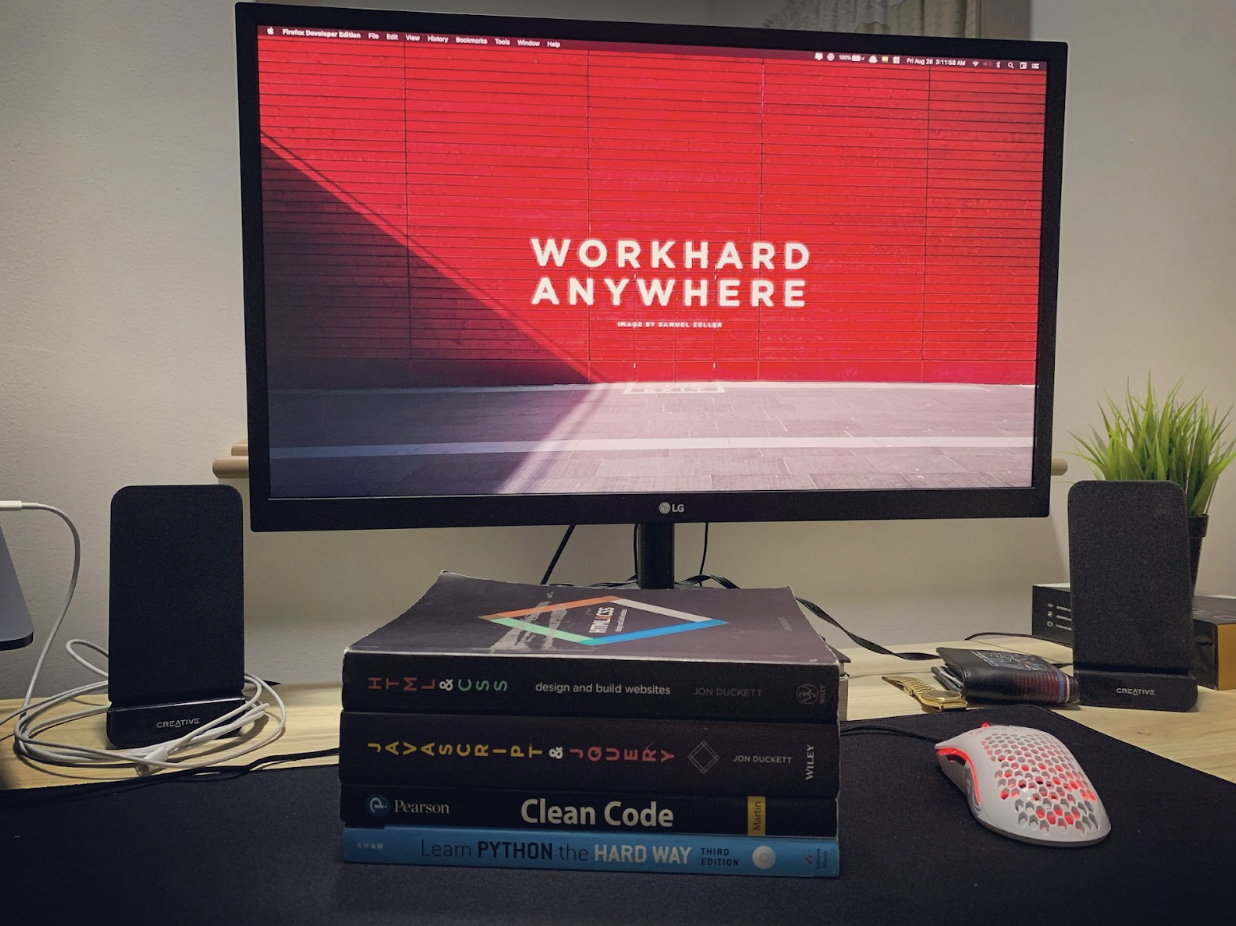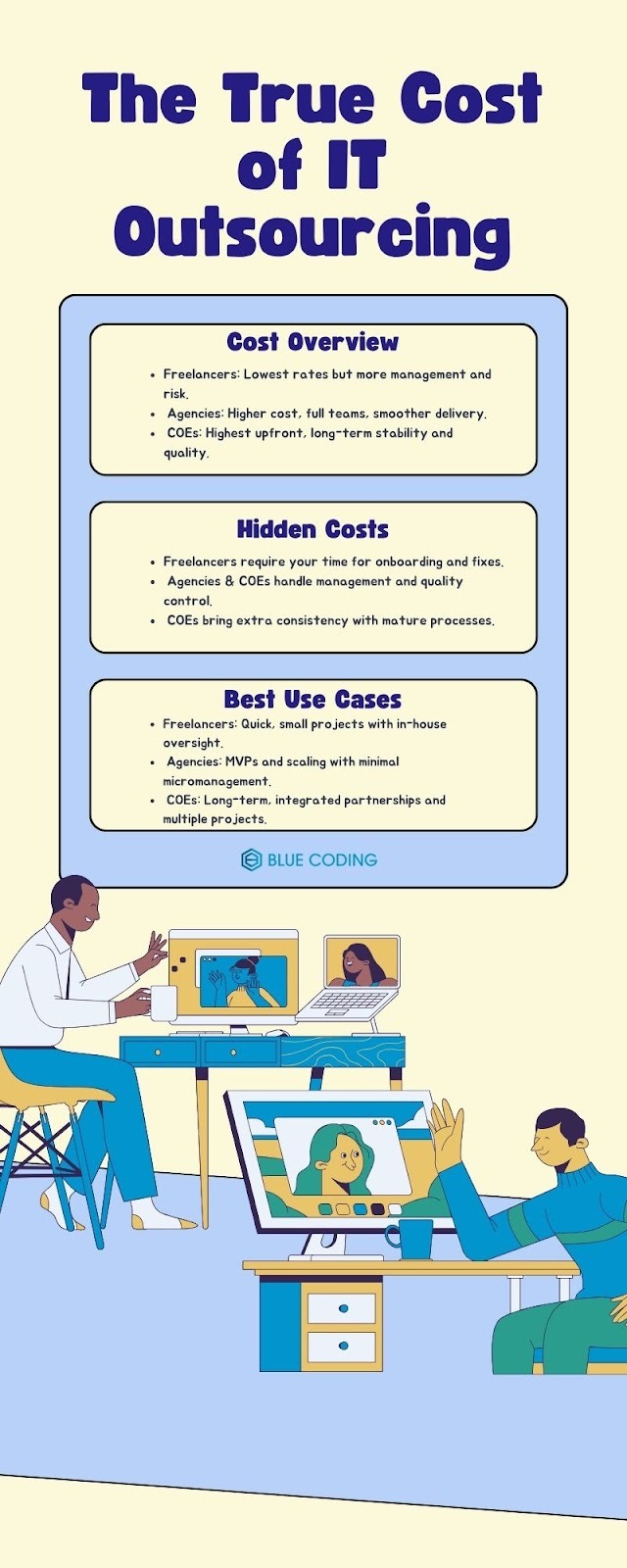 News
News
Outsourcing always starts with the same question: How much is this going to cost me? But if you stop at hourly rates, you’re only getting half the picture. Freelancers might look like the most affordable route. Agencies might feel expensive. And COEs? They usually don’t even make it into the conversation until you’re thinking long-term. But once you factor in what each model actually delivers and how much of your time it consumes, the cost story shifts completely. This post breaks it all down. We’ll go past the surface-level pricing and get into the real differences: hidden IT outsourcing costs, management overhead, output quality, and where each model actually makes sense. It will give you a deep insight into IT outsourcing vs freelancers' costs!
Cost Breakdown / Comparison
It’s easy to get caught up in hourly rates, but the true cost of outsourcing isn’t just about what you’re paying per hour; it’s about what you’re getting for that price, how consistent the output is, and how much time you’re spending managing it all.
→ Freelancers usually come with the lowest price tag. You can find skilled developers at competitive rates, especially in lower-cost regions. But those savings often come with trade-offs. You’re paying less because you’re also doing more, more follow-up, more project oversight, and sometimes, more rework. Plus, every freelancer has their own style, so maintaining consistency across multiple contributors can get messy fast.
→ Agencies tend to charge higher rates, but those numbers include a whole team and a built-in process. You're not just hiring a developer; you’re getting access to project managers, QA testers, and often even business analysts. The cost per hour is higher, but the output is more streamlined, and you’re not stuck holding the delivery together by yourself.
→ COEs, while often the most expensive up front, offer a longer-term, more cost-stable model. You’re building a dedicated extension of your internal team, which means deeper alignment, stronger retention, and higher-quality output over time. It’s an investment, but one that pays off if you’re thinking beyond a one-off project.
Hidden, Indirect & Management Costs - Freelancers vs Software Development Companies
At first glance, it’s easy to assume freelancers are the most cost-effective choice, but the deeper you dig, the more those “invisible” IT outsourcing costs start to surface.
→ With freelancers, you might not be paying for office space or benefits, but you are investing time in onboarding, project management, quality reviews, and sometimes even redoing incomplete work. Missed deadlines? That’s another delay that’s costing you. And if your freelancer goes MIA, you’re back to square one, which means recruiting, retraining, and realigning.
→ Agencies and COEs, on the other hand, often come with higher upfront costs, but they shoulder many of those hidden burdens. They’ve already trained their teams. They’ve built repeatable systems. Project managers, QA testers, and onboarding processes are built into their pricing, which means you spend less time babysitting and more time focusing on the bigger picture. With COEs (Centers of Excellence), that structure is even stronger as they’re built for consistency, not just delivery.
When to Choose Which
There’s no one-size-fits-all answer here. Each model, freelancers, agencies, and COEs, has its place, depending on what you’re building, how fast you need it, and how much oversight you’re willing to give.
→ Freelancers make the most sense for short-term tasks, isolated features, or low-risk projects where you can afford a little back-and-forth. If you already have an internal tech lead or someone who can manage the workload and review code regularly, a freelancer can be a lean and flexible fit. But if the project requires tight collaboration or multiple moving parts, relying on a solo contributor may create more work than it saves.
→ Agencies are better when you need a ready-made team that can take ownership of delivery. Whether you’re building an MVP or scaling an existing product, agencies can ramp up quickly and fill in the gaps for devs, designers, QA, and project management, all under one roof. This is ideal if you don’t want to micromanage or if your internal team is already stretched thin.
→ COEs (Centers of Excellence) come into play when you’re thinking about long-term strategy, not just execution. If you’re planning multiple builds, ongoing iterations, or need strong alignment with your internal culture and tech standards, a COE gives you that dedicated, embedded model. It’s less transactional and more about building a sustainable, high-quality development process over time.
Summary in a jiffy: In the end, it's about the context. Ask yourself, do you need quick hands, structured delivery, or a fully integrated tech partner? That answer will tell you where to lean.

Weighing the Trade-Offs: Freelancers vs. Agencies vs. COEs
Choosing between freelancers, agencies, and COEs is about how each model fits into your workflow, timeline, and long-term plans. Each option comes with its rhythm, level of support, and hidden effort. Before you commit to any path, it helps to understand what you’re signing up for. Let’s break down the real pros and cons of each, so you can make a call that works for your project.
Freelancers: The Flexible Solo Option
Pros:
Freelancers are usually the most affordable option. Their hourly or per-project rates tend to be much lower than what you’d get from an agency or COE. If you’re working on a quick task or a one-off feature, hiring a freelancer can be a simple, cost-effective move. They’re also extremely flexible, easy to hire, easy to scale down, and easy to swap out if you’re not happy with the results. And because you’re working directly with the person doing the work, communication can be quick and straightforward, especially when you only need someone short term.
Cons:
That flexibility comes with risk. With freelancers, you’re depending entirely on one person to carry the project, and that can be a gamble. If they disappear, burn out, or miss deadlines, you’re left scrambling. Quality can vary from one freelancer to the next, even if they come with great portfolios. You also end up doing more than you think. Managing deadlines, clarifying requirements, and testing code. It all lands on your plate! And once the project ends, all that domain knowledge walks out the door with them. There’s no process or handover unless you create it yourself.
Agencies: The Plug-and-Play Teams
Pros:
Agencies come with a built-in structure. With them, you are hiring a full team that includes project managers, QA testers, and sometimes even UX specialists. That means the project is handled with more consistency, and you’re not left managing the details yourself. Their processes are usually tight, which helps things run smoothly without constant check-ins from your side. Agencies are also easier to scale up when you need to move fast, since they already have the people and tools in place to expand when required.
Cons:
All of that support comes at a price. Agencies usually charge significantly more than freelancers, and you’re paying for the full team, even if you don’t need every role at every stage. Sometimes, agencies can feel too rigid in their approach. They’ve got their way of doing things, and not all of them are willing to bend their process to fit yours. You may also feel like just another client in their system, especially if they’re juggling multiple projects. If a developer rolls off your project, another might replace them quietly, which can impact continuity unless it’s managed well.
COEs: The Long-Term Partner
Pros:
A COE is all about building a long-term, deeply integrated relationship. This model gives you a dedicated team that operates like an extension of your own. Over time, they absorb your product vision, technical standards, and internal culture. That level of alignment creates strong output, high retention, and fewer surprises. The structure is also incredibly mature. You’re not just working with developers, you’re engaging with a full ecosystem of delivery leads, documentation practices, onboarding processes, and built-in quality control. The cost is predictable, especially if you're investing in multiple projects or ongoing feature development.
Cons:
That level of investment comes with a higher upfront cost. COEs aren’t cheap, and they take time to set up the right way. You’ll need to be ready for deeper collaboration, and that requires a clear product roadmap and some internal alignment on your side. This isn’t a quick fix model; it’s for teams thinking long-term. If you need something built fast or aren’t sure what direction your product is heading in yet, this structure might feel too heavy. And while COEs can adapt over time, they’re not as nimble when it comes to sudden changes or pivot-heavy projects.
Choosing the Right Partner
Wondering how to find a tech partner who truly understands your goals and delivers consistently? Many companies face the challenge of balancing cost, quality, and reliability when deciding between freelancers, agencies, or dedicated teams. Blue Coding’s approach focuses on building long-term, nearshore teams that act as an extension of your own, offering the stability and alignment that fast-paced projects need. If you want to explore how custom solutions can fit your business and drive results, feel free to contact us, and we will connect with you on a free strategy call!



